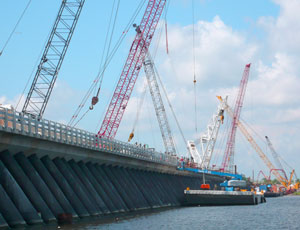Since 2005, federal government has invested $14.6 billion to improve perimeter protections around New Orleans to reduce the risk from hurricane storm surge. Many of the new or improved elements of the 350-mile-long system include features designed to reduce the cost of operation and maintenance.

“The Corps went to great lengths to reduce O&M costs for the local sponsor,” says Colonel Robert Sinkler, commander of the U.S. Army Corps of Engineers’ Hurricane and Protection Office in New Orleans, manager of design and construction. “One great example is the neoprene sleeves on the batter piles on the back side of the [Lake Borgne-Inner Harbor Navigation Canal] surge barrier,” he says. “Another is the use of T-wall construction in St. Bernard, which requires less long-term maintenance than earthen levees.”
Throughout the system, the Corps and its contractors considered features to reduce life-cycle costs, says Angela Desoto-Duncan, Deputy Chief of the HPO Execution Support Division, overseeing levee, floodwall, floodgate and pump station construction. Examples abound:
At the IHNC surge barrier gates, concrete guide walls are used instead of timber. Trusses are built from tubular steel sections instead of wide-flange beams to minimize sharp corners where finishes break down first and corrosion infiltration begins.
Miles of levee and floodwalls are also engineered to ease maintenance.
Deep soil mixing and wick drains were used in some areas to reduce settling and the need for future levee lifts.
“In places where we have a trolley-type flood gate, we are putting in a warning beam—like you see in a parking garage—so that oversized trucks will hit that before hitting and damaging the overhead beams of the gate,” Sinkler adds. “We widened the wildlife crossing gates on floodwalls in St Bernard so that a mower could fit through them.” Stab slabs on the floodwalls also were widened to facilitate mowing.
Dennis Kamber, senior vice president, Global Water Management, Arcadis U.S., Inc., who led the design team on one of the biggest features, the $1-billion Gulf Intracoastal Waterways West Closure Complex, says the design there includes many O&M-cost-reducing features. “We’re always concerned about O&M costs. That’s just good design,” he says.
At the WCC, designers used greaseless synthetic bearing inserts on the hinge and pintle of the 225-ft-wide sector gate. Kevin Wagner, the Corps’ WCC project manager, says “this system eliminates the need for a grease lubrication system and cuts bearing friction in half, reducing the loads on the operating equipment.” Wagner says the design also will increase the bearing life and allow for replacement of only the inserts at time of servicing, rather than adding the time and expense of removing and replacing or re-machining and lapping the large hinge and pintle balls and bushings.
The sector gate leaves at the WCC are defended against corrosion by the combination of a coal tar epoxy coating and a cathodic protection system, with a design life of 30 years, to reduce O&M costs as well, Wagner adds.
Other features at WCC include:
- Installation of several spare conduits from the pump station to the sector gate monoliths to facilitate future installation needs
- Supporting the weight of the sector gate leaves with buoyancy tanks and dewatering sumps, rather than carrying it on a submerged track and wheels, to reduce the demands on machinery
- Stainless steel sluice gates and bulkhead gates on the 75-ft water control structure
- And concrete capped dolphins instead of timber guide walls, which typically need repair or replacement every five years.
“The Corps is doing large, civil works projects and they don’t want them to be difficult or expensive to maintain,” Kamber says. “I’ve never personally worked with the Corps where they said to do it as cheap as you can. Most of these things they end up operating anyway.”
But that’s not to be the case in New Orleans, where Congressionally authorized funds do not provide funding for O&M of the improved perimeter system, which the Corps estimates will cost $38.3 million annually. Estimated annual O&M cost for the WCC alone is $3.7 million.

Post a comment to this article
Report Abusive Comment